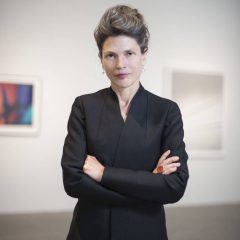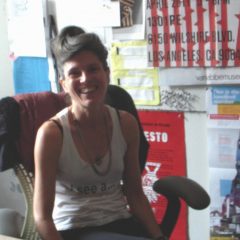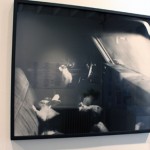
Cover of What Makes a Great Exhibition? In the course of reading the book, I didn’t find the answer, but I did find lots of food for thought.
The table of contents is a stunner in Philadelphia Exhibition Initiative’s new book, Questions of Practice: What Makes a Great Exhibition?, edited by PEI Director Paula Marincola.
It’s a who’s who of curating–Robert Storr, Carlos Basualdo; Thelma Golden in conversation with Glenn Ligon, Jeffrey Kipnis, Lynn Cooke, and more. It’s also a how-to-do-it of curating, but way way more. It’s the way way more part that makes this book more than just a manual for curators, but rather a discourse about values and culture.
White boxes, black boxes
The topics in the 14 essays range from film curator Mark Nash’s discourse on integrating black boxes in white ones to Golden and Ligon’s wry, sometimes prickly debate on a very different kind of black box–the exhibit that focuses on culturally specific work. I found both of these discussions particularly interesting.
The word issue
One of my favorite essays was devoted entirely to labels and text. ICA Senior Curator Ingrid Schaffner turned what could have been a narrow, boring subject into an essay on values and taste and cultural change, even as she ladled out bits of crunchy, practical advice.
For attitude, Kipnis wins the award, writing an iconoclastic rant that kept me intrigued by the passion and wit of his words:
“I abhor the supposition that exhibitions should be informative or, god forbid, educational. Is the work of Godard or Hitchcock or Beckett or Lecompte or Adams or Ashbery or Kiley or Gubaidulina or Serra or Koolhaas…or Koons educational?”
All this in an essay on architectural curating! Kipnis served as architecture and design curator of the Wexner Center for the arts before he became professor of architectural design and theory at Ohio State’s Knowlton School of Architecture.
I was also fascinated by the history of London’s innovative Whitechapel Gallery in an essay from the gallery director, Iwona Blazwick. Her essay turns out to be instructive about place, space and societal values. Of a Robert Smithson installation of a spiral on the floor of the gallery, she wrote, “Despite being monumental in scale the installation was also totally ephemeral, swept up and disposed of after the show, completing a life cycle like nature itself.”
Biennial shock
The challenges to the art world wrought by the rise of biennials and other art festivals cut across a number of essays, partially because the art world is still digesting and trying to understand the shift of taste-making power from galleries and museums. The Unstable Institution, by Basualdo, attacks the subject with a philosopher’s bent for dichotomizing–high versus low culture, global uniformity versus decentralized diversity; commercial evaluation of art versus museum evaluation of art; objects versus installations, and so forth. It reads like philosophy with no ultimate resolution, but with plenty of substance tackled as definitions fly back and forth.
(Basualdo’s essay as well as two others in the book, were previously published elsewhere, but all the essays were originally commissioned by PEI for this book).
The Gehry problem and other themes
The themes that interested me most in the majority of the essays were the relationship of architectural spaces to the art and the audience, a hot topic in these times of Frank Gehry, but one that really transcends his work; the relationship between curators, artists and their audiences; and the implied meanings beneath curatorial decisions. But there were plenty of nuts and bolts, like operating within limited budgets and how the traffic needs to flow through an exhibition.
Behind the scenes
The backstage examples from the real art world are an important part of the book’s charm. Storr wrote about what it was like working with Robert Ryman on the artist’s retrospective. Nash discussed his installation of “Experiments with Truth” at the Fabric Workshop and Museum.
Kipnis gets in a dig at the ICA here and its architecture, which he dubs a “gaping maw.” (Roberta and I decided yesterday, ironically, that that horrible architecture turns out to be a perfect space for the ambitous architectural experiments like Holiday Home and Fertilizers that ICA Director Claudia Gould has been commissioning). Farther afield several Documentas–Kassel, 11 and X–all got workouts.
Storr filled his essay with exhaustive advice perfect for other curators who have MoMA-sized budgets and resources. I preferred the essays that soared into bigger thoughts, like Detlef Mertins’ piece, Mies’s New National Gallery: Empty and Full.
Other contributors, are Lynne Cooke of Dia, Ralph Rugoff, Paula Antonelli interviewed by Bennett Simpson, Glenn Adamson (who tackles craft and comes out with a bold theory), and Mary Jane Jacob.
The book is now available on Amazon. I couldn’t yet find it on Reaktion Books in London and the University of Chicago Press here in the U.S., but Marincola said their web sites will carry it, too.
The mix of the real and the theoretical and the local, national and international turns this book into more than just a stocking stuffer for curators, but for anyone who has any kind of role in any kind of exhibit, from exhibitor to exhibitee and maybe even for the avid exhibition goer, like me.
What Makes a Great Exhibition?
Edited by Paula Marincola
$16.95
Philadelphia Exhibitions Initiative, Philadelphia Center for Arts and Heritage








